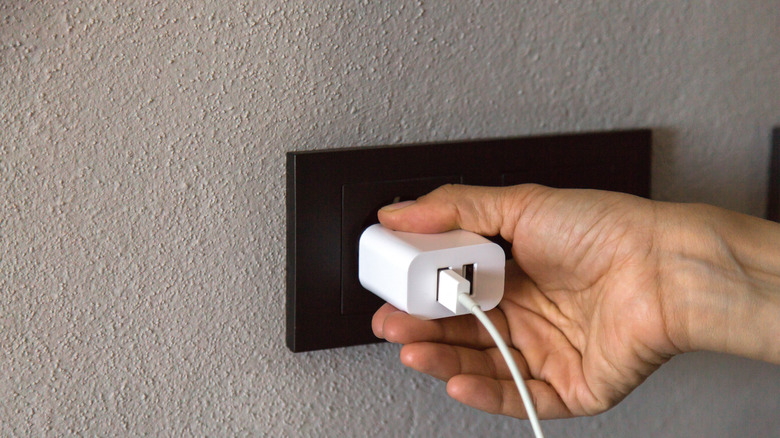You've Been Warned: Buying This Phone Accessory On Amazon Could Cost You
The global e-commerce market hit about $6 trillion in 2024, according to Statista. Amazon pulled in more than $638 billion that year — just over 10% of all online sales worldwide. That's a huge share — more than 1 in 10 online sales. Digital marketplaces like Amazon encourage extra spending, but there's a big problem lurking underneath. Counterfeit products flood these platforms and put shoppers at real risk. According to Amazon's official 2024 brand protection report, it seized and destroyed over 15 million fake goods in 2024 alone. Fakes keep slipping through to customers despite stricter enforcement and inspections. Buying a phone chargers, in particular, is a particularly common way to get scammed.
Back in 2016, Apple filed a federal complaint against Mobile Star LLC. Their internal testing revealed something shocking — nearly 90% of chargers and cables sold as "genuine" Apple products on Amazon were actually fakes. The complaint described these knockoff chargers as badly made. They had missing parts, bad design, and lousy electrical insulation. These aren't just performance issues. Those cheap, substandard parts mean your bargain hunt could end up costing you big.
How fake chargers can put you in danger
Fake phone often chargers fail even the most basic safety tests. They create real dangers — fires, electric shocks, property damage. Electrical Safety First tested counterfeit and lookalike iPhone chargers in 2017. They bought them from online stores and discount sellers. A shocking 98% failed crucial insulation and spacing tests. That means dangerous voltage levels could reach the outside casing and USB tips. Underwriters Laboratories ran a similar test in 2015 on 400 counterfeit Apple power adapters. Only three units passed basic electrical safety standards. The rest had poor insulation or allowed dangerous currents that could shock or electrocute someone. These awful failure rates show how fakes slip through Amazon's third-party marketplace. They often use fake reviews to look legit.
The problems go beyond nameless knockoffs. Even branded devices with missing safety features get recalled. In April 2025, the U.S. Consumer Product Safety Commission recalled more than 429,000 Casely Power Pods 5000 mAh MagSafe portable chargers. Dozens of people reported overheating, battery swelling, or fires. Six people got minor injuries. Investigators keep finding that dangerous chargers lack important safety parts. No fuses, cheap plastics that aren't flame-retardant, no thermal cutoffs. Some knockoffs waste electricity even when you're not using them, driving up your monthly bill. These design shortcuts put buyers at serious risk. Overheating, sparking, fire-related injuries — all the stuff that real products are built to prevent.
How to spot a safe charger
To spot a safe charger, look for recognized certification marks, solid build quality, and stick to trustworthy sellers, as many popular technology brands are risky to buy on Amazon. In particular, Apple's own support page explains the MFi badge — short for Made for iPhone/iPad/iPod — shows the product got tested by Apple for compatibility and safety. Check the packaging for that logo or search Apple's database to confirm. Any genuine USB charger needs clear safety symbols. The UL Listed mark means it passed Underwriters Laboratories standards. Intertek's ETL Listed mark verifies it meets North American electrical rules through independent tests.
Apple points out that authentic power adapters feel sturdy. They have voltage and amperage details printed clearly on the case. Fakes often mess up the labeling. Grab yours straight from the maker's site, their stores, or authorized spots to avoid uncertified products. Take Apple's 20W USB-C adapter, for example — it went for $19 in July 2025. Uncertified knockoffs on Amazon sold for way less. Getting proper certification and buying from reputable sellers isn't optional — it's the only way to avoid a potential disaster.


